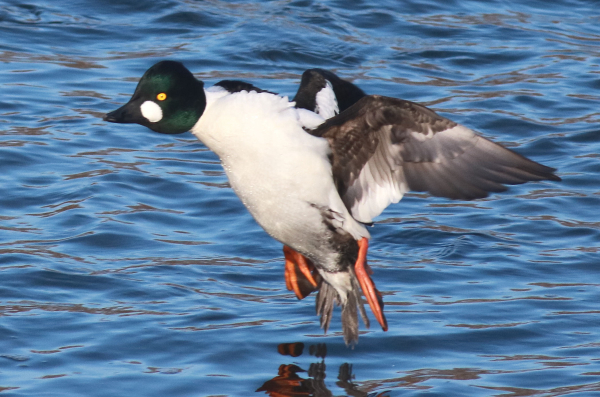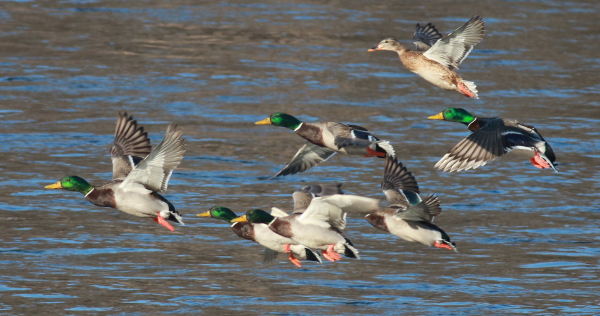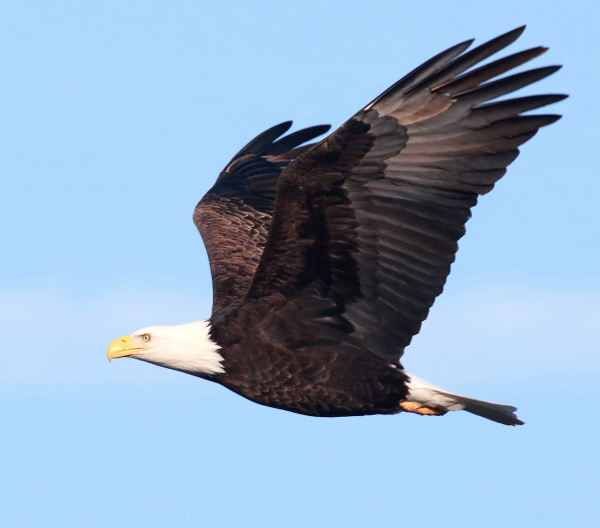Thursday afternoon, on my way home from Minneapolis, it was near-perfect timing to photograph a while at the Monticello Trumpeter Swan photography site. The photo episode provided a fun diversity of birds that seemed to flow by (fly by) upstream along the Mississippi River. Swans, Mallards, Common Goldeneyes, Canada Geese, and Bald Eagles all provided prime photo ops, which I enjoyed in the company of another photographer – Blaine. It was a rare opportunity to photograph with another enthusiast, and we talked a lot as the action transpired before us. All the birds were hyperactive compared to recent stops I’ve made there, which made the chance to share the action and a back and forth discussion.
Blaine was most interested in the goldeneyes, probably because the other birds are pretty easy to photograph, while Common Goldeneyes are the least likely to fly close to the river’s edge. During my visit, two special things happened: A hen Mallard led a dozen drakes on a meandering pairing flight that provided plenty of action; plus about 100 Mallards took flight in two successive waves, and sure enough, a big adult Bald Eagle appeared low overhead, providing a nice flyby photo opportunity as it winged broadside in beautiful light. We were lucky to get some goldeneye action too – more than I’ve ever had there, which Blaine especially appreciated.

If only you could hear these grand Trumpeter Swans calling – the largest and loudest of all waterfowl.
Turn of the Century Changes
We were talking about our lenses when Blaine raised the question about the turnover from film to digital photography, and suddenly I felt like a historian describing the difference between using a typewriter and a computer. I kept it pretty simple, but then Blaine asked if I was a film holdout, or whether I was quick to switch to the digital photography world. That made me recall the four or five year period when photographers began switching over, which required a new camera purchase; but thankfully, we could use the same lenses with the new digital cameras. And best of all, the same lens magnified a bird 1.4 times, making an 8x (400mm) telephoto lens create an 11x magnification – thank you very much!
Continuing, I explained that at first digital quality wasn’t very good. I can remember in the late ’90s that reputable photographers wrote about how digital photos would never rival the quality of slide images. That notion persisted among a few holdouts a couple years, but no longer. The second generation of digital cameras that provided better quality, better than slides at that point. After the turn of the century, the quality of digital photos was clearly improved to the point where the switch became pretty universal.

Common Goldeneyes provided opportunities to take action photographs of males flying, landing, and swimming (no females ventured close).
Looking back, it’s actually surprising how quickly the turnover from 35mm film cameras to digital cameras happened. And in two or three year increments, digital cameras continue to become better and better. I find myself buying a new camera body in those two or three year increments to get use the best possible balanced with my personal economics. Actually, it’s amazing the quality of photos we get from reasonably priced camera models – and they keep getting better.
Some years ago Kodak stopped manufacturing 35mm camera film, and camera companies don’t market 35mm cameras – this historic photo equipment is now museum fodder, although mine resides in the back of the walk-in closet in my “museum,” along with a few of the handy little plastic film canisters, lead-lined X-ray proof film bags to hold your rolls of film when passing through airport scanners, and other outdated products.
Then too, as I am always quick to point out, digital photography made a computer teamed with photo editing software our modern digital darkroom. Sure, although I always took color slides and prints, while in college I occasionally took black-and-white film photos and printed enlargements in the darkroom using the series of chemical baths – literally in the dark. Eventually I even processed a couple rolls of color slide film – just to do it – but I didn’t want to take the chance of making any mistakes processing slides, so strictly used a photo lab to do the processing. Hey, we don’t need to visit the local photo lab anymore, if you can even find one, unless you have a given need for a quality print enlargement or a selection of photos you wish to give to others. Early on, by using photo paper and our computer printers, we’ve been able to take care of many of our photo printing needs.

As many species of ducks choose mates, the accompanying displays are often accented by pairing flights. Here a female Mallard lead a cohort of males on a low undulating pairing flight.
Futuristic Options
Today’s cameras offer an amazing array of features and options, with WiFi and Bluetooth connections between your camera and computer, your camera and cellphone, and between your camera and printer; plus you can post directly to Facebook or other internet pages, or to the cloud. So now, not only are cameras computerized, they are computer connected and, of course, they double as video cameras!
I keep it simple; I have always preferred still photography and consider video a whole different animal, and these days as long as I have a quality digital camera with an up-to-date sensor and processor that create high-quality photos – with auto-focus, continuous shooting at 5 frames per second or better, and an advanced light meter with an aperture-priority setting, I’m in business and using my treasured digital equipment in the field every week, if not every day.
But I guess the big question is: “What will bird photography be like in a decade? What will transpire by 2030?”

Any time flocks of birds flush without apparent reason, look overhead to see if a bird of prey is approaching. In this case, after about 100 Mallards flushed, an adult Bald Eagle appeared and flew low in beautiful afternoon sunlight.
Look at the bag of worms that Blaine opened when he brought up the transition from film to digital photography! (ha-ha) After about 40 minutes, as the light for photography was waning, I dismissed myself due to cold fingers, toes, and face. But it was a productive and enjoyable photo episode, and it was great fun to share the action, and some historic insights in the process. Give your camera a workout as March progresses!
Article and photos by Paul Konrad
Share your bird photographs and birding experiences at editorstbw2@gmail.com